Sigma DP1 Review
Review Date: April 21st 2008
Author: Mark Goldstein
Leave a comment about this Review
|
Introduction
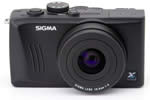
Who would have thought that Sigma, with its comparatively tiny budget and short history of producing cameras, would release one of the most important compact digital models of 2008, and perhaps of all time? The principal reason for this bold assertion is what's hidden inside the DP1. This is the first ever pocket-sized camera to feature an APS-C sized sensor, as used in much larger and heavier DSLR models, and it consequently promises to deliver better image quality than ever seen before in such a small device. First shown as a prototype way back in September 2006, the Sigma DP1 has flattered to deceive ever since, with numerous delays threatening its very existence, but Sigma have thankfully put those problems behind them and finally released it. The DP1's headline features are a 14.06 megapixel Foveon X3 sensor, 28mm F/4 lens, 2.5 inch LCD screen, and full range of creative shooting modes. You'll have to have deep pockets though, as this camera retails for an eye-watering £550 / $800. Serious photographers have almost literally been crying out for a second, compact camera that delivers DSLR-like control and results, so does the Sigma DP1 deliver on its long-awaited promise?
Compare Prices
Support PhotographyBLOG: Buy the Sigma DP1 from one of our affiliate retailers:Ease of Use
The Sigma DP1 has a substantial, serious design that is rather box-like but not altogether unattractive. Measuring 113.3(W)×59.5mm(H)×50.3mm(D) and weighing 250grams, the Sigma DP1 fits into a coat pocket or small camera bag, but it's too big and bulky for a trouser or shirt pocket, primarily because of the lens housing which protrudes quite a long out from the front of the camera body. The DP1 becomes even more cumbersome if you add the optional optical viewfinder or lenshood. Utilising an aluminium alloy body, it's an exceedingly well built camera, certainly up there with the best that the other manufacturers have to offer. The DP1 has an under-stated, all-black appearance, and together with the slightly heavier weight this lends the camera a professional look and feel. The all-metal tripod mount directly inline with the centre of the lens is a giveaway sign that this is intended to be a serious camera (most compacts have a plastic mount squeezed into one of the corners).
The 28mm, F/4 lens dominates the front of the camera. Sigma, with its long history of making lenses for other manufacturers' cameras and more recently it's own DSLRs, has developed this lens specifically for the DP1. Despite offering a fixed-focal length, the lens extends by approximately 3cms when the camera is turned on, accompanied by a quite audible mechanical noise. The construction of the lens feels rock-solid with no play at all in the metal lens barrel.
Obviously the 28mm lens will immediately put a lot of people off the DP1. Sigma themselves have hinted at releasing DP2 and DP3 models later in 2008, with at least one presumably offering a more popular zoom lens. 28mm is perfect for wide-angle shots, so if you're a fan of land and city scapes, or you're happy to get up close and personal, the combination of the DP1's lens and every photographer's constant companion, their legs, proves to be more versatile than you might first think. The maximum aperture of F/4 is slower than many photographers might have wished for, especially given the lack of an anti-shake system, but it's perhaps understandable given the relative physical size of the lens and the camera body.
Also on the front of the camera is a small dimpled area to the left of the lens (looking from the front) which helps you to keep a firm hold, replicated on the rear below the digital zoom buttons. The 2.5 inch LCD screen is a good compromise given the size of the DP1, being small enough not to overpower the rest of the design, but large enough to easily frame and review your images. It displays 100% of the image and the 230,000 pixel resolution is perfectly adequate, plus there are a couple of options for increasing or decreasing the brightness of the screen if you don't like the default setting.
If you'd prefer using an optical viewfinder to frame your images, Sigma offers the optional VF-11 viewfinder, which fits into the flash hotshoe on top of the camera (you can also use other third-party viewfinders with the DP1). This system does give you a choice, but it comes at the cost of not being able to use the optical viewfinder and an external flashgun at the same time, and also the hefty literal cost of £90 (£50 if purchased in kit form with the camera). The VF-11 was a very tight fit in the DP1's hotshoe, so there's no danger of it falling off, although it's small enough to misplace when taken off the camera.
 |
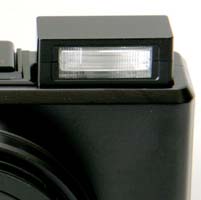 |
| Optical Viewfinder | Pop-up Flash |
As for performance, Sigma's viewfinder solution offers a large, bright view of the scene in front of you. On the other hand, it doesn't provide any feedback to the photographer, other than showing a thick white border which indicates very approximately what part of the scene the DP1 will capture. I found that the recorded image was quite a bit bigger than this border, and also that it disappeared against a bright background, effectively making framing your subject a point and hope experience. Also the only way of knowing that the camera has focused correctly is the small green LED above the LCD screen, which you can just see out of the corner of your right eye when looking through the optical viewfinder. Despite using a DSLR camera for the majority of my photography, I more often than not found myself holding the DP1 at arm's length and using the LCD screen, rather than the optical viewfinder.
At the heart of the Sigma DP1 is the APS-C-sized Foveon image sensor. The exact size of the image sensor used in the DP1 camera is 20.7mm x 13.8mm, which is approximately seven to twelve times larger than the 1/1.8inch to 1/2.5inch image sensors used in other compact digital cameras. Sigma are the only manufacturer to use the Foveon X3 sensor, and as with the SD14 DSLR camera, they quote the resolution as 14 megapixels. Whilst this is technically true, in that there are 14 million pixels on the sensor, it's very difficult to compare it with a conventional Bayer CCD/CMOS sensor. This is because the Foveon solution uses 3 layers of 2652×1768 pixels, stacked on top of each other, with each photodiode capturing all of the RGB data. Sigma and Foveon claim that this results in better looking colour images straight out of the camera when compared to a CCD/CMOS sensor. Whilst this may be true, from the user's point of view the final image is 2652×1768 pixels in size, a little smaller than a 5 megapixel photo, which limits how big you can print or crop the native image without interpolating it in Adobe Photoshop or another application. As a comparison, images from the 14.6 megapixel Pentax K20D are 4672x3120 pixels in size.
Just like a DSLR, the DP1 offers both JPEG and RAW recording formats, one of a handful of compact cameras to do so. There are 3 different JPEG compression levels, and a choice of four sizes including a 16:9 widescreen mode. The RAW files are saved in the Sigma X3F format, which at the time of writing can only be processed using the supplied Sigma PhotoPro RAW image developer. This is a simple and straight-forward application that doesn't compare at all well with Lightroom or Aperture in terms of features, but gets the job done until future updates are released to support the DP1.
Unfortunately the DP1 has a real problem with recording RAW files, taking around 7 seconds to store them, during which the camera can't be used. Sigma are marketing the DP1 as a real DSLR alternative or backup camera, and that's what the majority of users will be shooting in, so you'd expect it to offer DSLR-like performance for processing RAW files. There's even a 2 second lockup when shooting in JPEG mode at full-size, despite using a SanDisk Extreme Ducati Edition SDHC card with read/write speeds of 20 MB/second. When you factor in the slow auto-focus system (more on this below), this makes the DP1 ill-suited to quick moving subjects (or in the case of RAW mode, any moving subject).
The start-up time from turning the Sigma DP1 on to being ready to take a photo is quite slow at around 3 seconds. In the fastest Continuous mode the camera takes 3 frames per second for an unlimited number of images at the highest JPEG image quality, and commendably in RAW mode too, which is very good for this class of camera. Unfortunately, the DP1 locks up completely for around 10 seconds when shooting a burst of Fine JPEGs and even longer for RAW files, so while you can certainly capture 3 JPEGs or RAW files in a second, the camera is effectively out of action for the next 10-15 seconds.
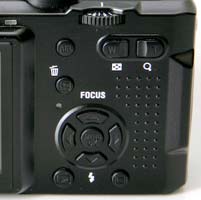 |
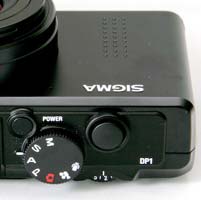 |
| Rear Controls | Top Controls |
The Sigma DP1 offers a full range of advanced exposure controls, including aperture-priority, shutter-priority, manual and manual focusing, with Auto and Program AE modes catering for the less experienced. There are no auto-everything or scene modes on this camera, which is a veritable breath of fresh air at a time when most manufacturers are stuffing their cameras full of clever technologies that take control away from the user. Shutter speeds and apertures are set by using the left and right buttons on the navigation pad, with the Exposure Compensation button switching between the two in Manual mode.
The DP1 has three metering modes, Evaluative Metering, Center Weighted Average Metering and Spot Metering. I found that the DP1 got exposures right 95% of the time when using the Evaluative Metering mode, with Spot Metering useful for the remaining 5%. Exposure compensation can be set in 1/3 stop increments from +3.0 to -3.0 stops and a simple auto bracketing function is also available.
Focusing is one of the weaker points of the DP1. There are 9 focusing points to choose from, but you can only select one at a time, with no multi-AF point system that virtually all other cameras have. You have to go into the menu system and scroll down the long list of options to change the AF point, which slows down the camera operation and soon becomes irritating. It's easier and quicker to set the focus to the middle point, then focus by half-pressing the shutter button and recompose the frame for off-centre subjects.
The DP1 offers a rather confusing choice of focusing options, with two autofocus modes available. The normal mode has a focusing distance from 50cm to infinity, but it's also possible to shorten the minimum focusing distance to 30cm using the second mode. I didn't notice any speed differences between the two modes, so permanently set the DP1 to the 30cm short mode. Finally, the DP1's autofocus system isn't what you'd call snappy, especially in low-light. It always locks onto the subject eventually, but there's a noticeable delay that doesn't make this camera particularly good for action photography. Note that the DP1 doesn't have a built-in focus assist lamp.
Manual Focus is also available, which obviously avoids the auto-focus lag and speeds up the camera. The DP1 has a dedicated manual focus dial located above the digital zoom buttons on the rear of the camera, with markings indicating 0.3m, 0.4m, 05m, 07m, 1m, 2m, 5m and infinity. The dial rotates freely with no lock at the various distances, so it's easy to set the distance, put the camera in your pocket, and then find that the dial has moved to another position. It is possible to magnify the LCD display to check the focusing by pressing the Display button, although this doesn't provide enough magnification or clarity to ensure precise focus.
The Sigma DP1 offers two flash solutions, the built-in pop-flash unit which is positioned above and to the right of the lens, and an optional flashgun which fits in the external hotshoe directly above the lens. The pop-up flash is opened via a switch on the back and isn't very powerful, with a guide number of 6 and a range of 30cm-2.1m at ISO 200. On the upside it does feature flash exposure compensation in 1/3 stops increments for more precise control. Sigma suggest that you use the new, optional EF-140 DG flashgun with the DP-1, but again there are compatible third-party alternatives available.
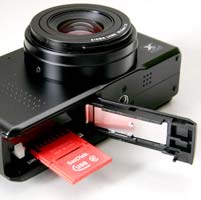 |
 |
| Memory Card Slot | Battery Compartment |
A dedicated lens hood is the final optional accessory for the DP1. This blocks out extraneous light and helps avoid flare, useful given the wide-angle nature of the lens, although unfortunately we didn't have one to test. The lens hood also includes a hood adapter which is designed to accept a 46mm lens filter, so you can add things like a polarizer, UV or close-up macro filter. The closest distance that you can focus on a subject is 30cms away from the camera when it's set to Full Focus mode, so you'll need to buy the lens hood and then fit a third-party close-up macro filter if you want to get really close to your subject.
The main menu system on the Sigma DP1, accessed by pressing the Menu button in the middle of the navigation pad, is rather rudimentary but simple to use. There are two main menus, Shooting Menu and SetUp. Virtually all of the camera's main options, such as image size, sharpness, metering mode and continuous mode, are accessed here, so the Shooting Menu has 15 options spread over 3 screens and the Setting menu has 17 options spread over 3 screens. Due to the large LCD screen and restricting the number of on-screen choices to 7, the various options and icons are quite clear and legible, and each option uses a combination of text and helpful small icon.
If you have never used a digital camera before, or you're upgrading from a more basic model, reading the easy-to-read but rather brief 100+ page manual before you start is a must. Thankfully Sigma have chosen to supply it in printed format, rather than as a PDF on a CD, so you can also carry it with you for easy reference in the field.
Once you have captured a photo, the Sigma DP1 has a rather limited range of options when it comes to playing, reviewing and managing your images. You can instantly scroll through the images that you have taken, view thumbnails (9 onscreen at once), zoom in and out up to 8x magnification, view slideshows with various configurable options, set the print order, record a soundclip, lock, mark, and rotate an image. The Display button toggles detailed settings information about each picture on and off, such as the ISO rating and aperture / shutter speed, and there is a small RGB histogram available during playback (but unfortunately no when taking a picture). When taking a photo, pressing the Display button toggles between the detailed information, gridlines to aid composition, no information and turning the LCD screen off.
In summary the Sigma DP1 is a no-frills camera that some people will regard as overpriced and under-featured, whilst others will appreciate its stripped down, back-to-basics approach. Due to the slow and simple auto-focus system and even slower file write times, especially when shooting RAW, the DP1 is not a good choice for fast-moving subjects.
|
![]() PhotographyBLOG
is a member of the DIWA
organisation. Our test results for the Sigma DP1 have been submitted to DIWA
for comparison with test results for different samples of
the same camera model supplied by other DIWA
member sites.
PhotographyBLOG
is a member of the DIWA
organisation. Our test results for the Sigma DP1 have been submitted to DIWA
for comparison with test results for different samples of
the same camera model supplied by other DIWA
member sites.
